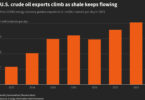DUBAI (Agencies): The Saudi Arabia Purchasing Managers’ Index (PMI) climbed to 56.8 in March, from February’s 56.6. The latest reading was the highest since December 2017 and indicated one of the strongest growth performances over the past three-and-a-half years.
“The average PMI reading for the first quarter of 2019 was 56.5, indicating the strongest quarterly expansion in the non-oil private sector since the fourth quarter of 2017,” said Khatija Haque, Head of Mena Research at Emirates NBD. “However, the rebound in new orders and business output in recent months has not fed through to job growth, with private sector employment declining for only the third time in the series history last month. There also appears to be very little pricing power for firms, with selling prices declining (albeit only marginally) for the fifth month in a row.”
March saw the rate of new business growth accelerate for the fifth time in the past six months to the highest since April 2015. Surveyed firms reported that the upturn largely reflected stronger market conditions, with greater sales efforts, improving product offerings and competitive pricing also helping to attract customers. New export orders rose for the first time in three months but only marginally, indicating that the main impetus continued to come from domestic sources.
The output of goods and services across the non-oil private sector increased at a faster rate in March. Growth in output was at a seven-month high, though still below the historical series average (since 2009). Higher business activity in turn saw companies raise their buying levels and boost stocks of purchases.
Despite the sustained recovery in demand, there remained only mild pressure on business capacity. The level of backlogs of work barely rose during March, posting the smallest monthly increase since October last year. As such, data showed a reduced appetite for new hires, with non-oil private sector employment falling slightly to end a near five-year sequence of workforce growth.
With firms looking to boost sales through competitive pricing, March saw a slight decrease in average prices charged for goods and services – the fifth in as many months.
That said, most firms left their selling prices unchanged. On the cost front, data showed a modest rise in firms overall operating expenses, in part reflecting slight increases in both purchase prices and staff pay. Finally, confidence towards future output remained strongly positive, despite the degree of optimism easing further from January’s recent peak.






